Natural Fiber Biocomposites in 3D & 4D Printing: A Review
In an article published in the journal of Materials & Design, titled “A review of 3D and 4D printing of natural fiber biocomposites,” researchers review the fascinating evolution of natural materials and their effectiveness in digital fabrication.
Composites are generally created when one material needs additional strength or some other physical property to be as effective as possible. In terms of FFF 3D printing, many different composites are available to improve ongoing challenges with mechanical properties. Even as promising composites are created, however, research continues to uncover concerns regarding issues like adhesion, porosity, and a variety of potential defects.
With the addition of natural fibers, materials offer a host of benefits for 3D and 4D—from improving mechanical properties to shape shifting due to environmental changes as required. The use of natural fibers is more environmentally friendly, but more complex knowledge is often required in choosing the correct materials and then accounting for sensitivity, temperature, moisture, overall composition, and variabilities. If the goal is to create high-performance parts, composites should be composed of unvaried, stable fibers, with as little porosity or potential for defects as possible. Natural fibers are dependent on chemical composition, and are anisotropic.
“The relationship between their microstructure, composition, and properties is typical of naturally optimized biological materials,” stated the researchers. “For example, the bast fibers that provide stability to the plant (e.g. hemp, flax) have greater stiffness and strength than fruit fibers dedicated to energy dissipation such as coir fibers.”
Because the selection of materials is so important for gaining the desired results in 3D printed parts, issues like non-linear behavior must be examined ahead of time. Previous research by Shah et al. suggested the evaluation of tensile modulus. Users should also consider stress transfer at the interface to ensure suitable composite properties like:
- Fiber length
- Diameter
- Tensile properties
- Interfacial shear strength
Because natural fibers are more complex, they are often bundled together, and bonded with middle lamellae:
“This bundling is the result of the original material architecture of the plant. The scale of the fiber bundle is generally referred to as ‘technical fibers’ in the literature.”
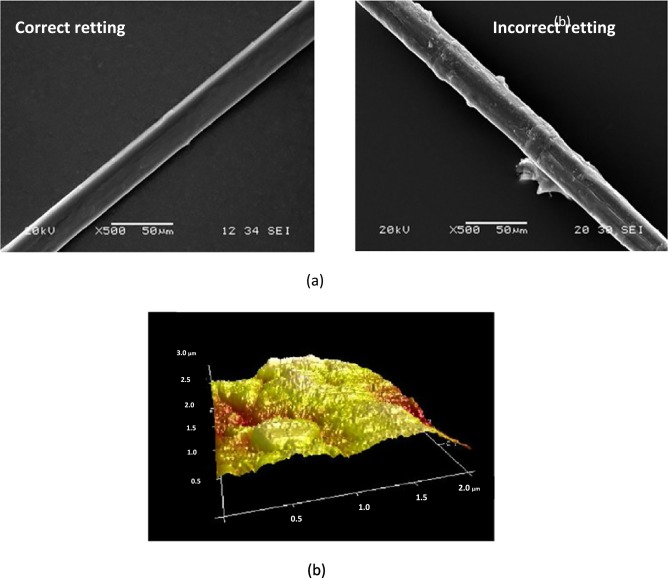 (a) SEM micrograph of single flax fibre surface with correct (left) and incorrect (right) retting. Correct retting leads to a homogeneous smooth surface whereas incorrect retting induces low adherent polysaccharidic residues (b) AFM image of a flax fibre surface with incorrect retting producing a rough surface.
(a) SEM micrograph of single flax fibre surface with correct (left) and incorrect (right) retting. Correct retting leads to a homogeneous smooth surface whereas incorrect retting induces low adherent polysaccharidic residues (b) AFM image of a flax fibre surface with incorrect retting producing a rough surface.Single fibers can be scaled after bundles are split during processing. For better adhesion with materials like PLA, previous researchers have been successful in cleaning fibers with water; however, it has been noted that when entire bundles are treated, effectiveness is limited.
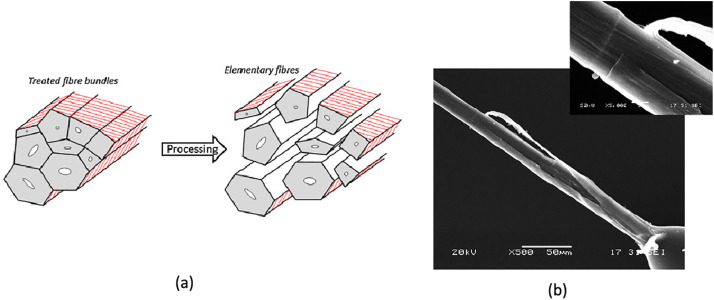 (a) Example of fiber bundle division into single fibers during processing, highlighting the reduction in the effectiveness of surface treatments [48], (b) Detail of a flax cell wall peeling during microbond testing [39], which indicates that the weakest interface may be the cell wall interface compared to the fiber/matrix interface.
(a) Example of fiber bundle division into single fibers during processing, highlighting the reduction in the effectiveness of surface treatments [48], (b) Detail of a flax cell wall peeling during microbond testing [39], which indicates that the weakest interface may be the cell wall interface compared to the fiber/matrix interface.Chemical treatments and the use of polymers with varying viscosity may decrease both porosity and “thickness variations,” leading Filgueira et al. to use “subsequent extrusion” to lessen fiber size, porosity, and roughness. This correlates with numerous other research papers explaining that increased extrusions allowed for better homogenization, as well as decreasing natural fiber length, and fiber bundle division.
 Evolution of filament surface roughness with fiber content with PCL/Cocoa Shell Waste (CSW). Increasing fiber content induces filaments with a rough surface.
Evolution of filament surface roughness with fiber content with PCL/Cocoa Shell Waste (CSW). Increasing fiber content induces filaments with a rough surface.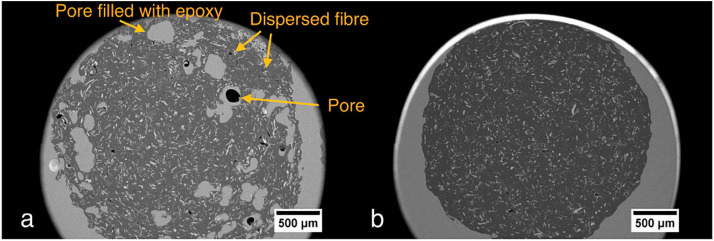 Example of the microstructure of (a) extruded filaments with TMP fiber of 400 μm length and 38 μm width (b) and two subsequent extrusions of TMP/bioPE biocomposite. The subsequent extrusion leads to a shorter fiber, better homogenization, and lower porosity content.
Example of the microstructure of (a) extruded filaments with TMP fiber of 400 μm length and 38 μm width (b) and two subsequent extrusions of TMP/bioPE biocomposite. The subsequent extrusion leads to a shorter fiber, better homogenization, and lower porosity content.Natural fibers examined include:
- Hemp
- Flax
- Shives
- Jute
- Wood
- Wood flour
- Macadamia nut-shell waste
- Harekeke fibers
- Rice straw
- Coconut
- Bamboo flour
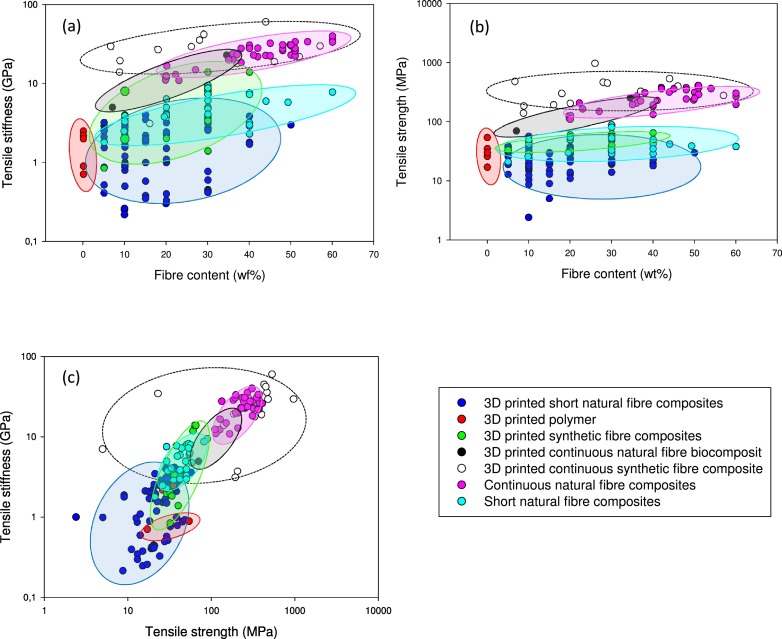 Literature review on the tensile properties of natural fibre-based biocomposites manufactured by 3D printing. Stiffness (a) and strength (b) as a function of fibre content; (c) Stiffness as a function of strength of 3D printed pure polymer, short and continuous fibres natural fibre composites and conventionally manufactured short and continuous fibres natural fibre composites (injection, compression moulding) [29,56,58,68,74,75,[77], [78], [79], [80], [81],90,[96], [97], [98], [99],[101], [102], [103], [104], [105],110,111,116,[118], [119], [120], [121], [122], [123], [124], [125], [126], [127], [128], [129], [130], [131], [132], [133], [134], [135], [136], [137], [138], [139], [140], [141], [142], [143], [144], [145], [146], [147], [148], [149], [150]].
Literature review on the tensile properties of natural fibre-based biocomposites manufactured by 3D printing. Stiffness (a) and strength (b) as a function of fibre content; (c) Stiffness as a function of strength of 3D printed pure polymer, short and continuous fibres natural fibre composites and conventionally manufactured short and continuous fibres natural fibre composites (injection, compression moulding) [29,56,58,68,74,75,[77], [78], [79], [80], [81],90,[96], [97], [98], [99],[101], [102], [103], [104], [105],110,111,116,[118], [119], [120], [121], [122], [123], [124], [125], [126], [127], [128], [129], [130], [131], [132], [133], [134], [135], [136], [137], [138], [139], [140], [141], [142], [143], [144], [145], [146], [147], [148], [149], [150]].With the exception of an example by Tarrès et al. showing that “a compatibilized bioPE reinforced with thermomechanical pulp (TMP) fibers showed an increase in stiffness and strength with the addition of 10 to 20% of fibers,” in general natural fibers were rarely found to comprehensively improve biocomposite mechanical properties.
Natural fibers may be more beneficial when used as additives for biocompatible materials and waste—reducing polymer content and therefore, making the process more affordable. They can also add to “biobased content” as well as contributing further to aesthetics in terms of color and texture. In this study, however, the researchers noted that it is challenging to use natural fibers for semi-structural applications.
Printing and slicing options also have a huge effect on biocomposites. This includes:
- Infill percentage
- Printing pattern
- Raster angle
- Printing height
- Printing orientation
- Printing/bed temperature
- Printing speed
Previous research has shown that wood-based biocomposites retain good tensile properties at higher temperatures, while hemp/PLA biocomposites may also better. Little research has been performed regarding biocomposites and printing speed, but there may be some evidence that faster printing could prevent natural fibers from breaking down.
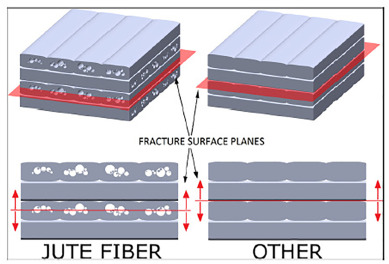 Schematic view of the fracture plane for jute fibre-reinforced ABS compared to neat ABS [77]. A cohesive fracture within one layer and more specifically within jute fibre bundle is observed for jute/ABS. The fracture occurs in the interlaminar area for neat ABS.
Schematic view of the fracture plane for jute fibre-reinforced ABS compared to neat ABS [77]. A cohesive fracture within one layer and more specifically within jute fibre bundle is observed for jute/ABS. The fracture occurs in the interlaminar area for neat ABS. a) Effect of layer height on wood, 0.3, 0,2 and 0.1 mm [126]. Higher layer height set by the slicer generates a microstructure with higher porosity content. b) SEM micrography of printed wood/PLA biocomposites with raw filament cross-section, compressed printed samples and various filament thickness.
a) Effect of layer height on wood, 0.3, 0,2 and 0.1 mm [126]. Higher layer height set by the slicer generates a microstructure with higher porosity content. b) SEM micrography of printed wood/PLA biocomposites with raw filament cross-section, compressed printed samples and various filament thickness.4D printing offers new avenues for the use of materials, especially as they can be used to shapeshift for greater efficiency. The authors point out that both 3D and 4D printing offer great potential for expanding the use of materials—and biocomposites in particular—on a “similar scale as their synthetic counterparts.” While discontinuous fibers or powder-reinforced polymers tend to be used for 3D printing, tensile properties may only prove to be satisfactory in comparison to better results still found with injection or compression molding. Stiffness is improved for the composite, however.
4D printing is a fascinating technology as it goes beyond 3D printing in allowing for much smarter, complex structures that can be manipulated through the environment. Actuation performance is still not found to be as good though in comparison to traditional methods of production.
“This is a critical dimension for further research since fibers act as the main actuating agent,” stated the researchers, continuing on to explain that there is great potential for natural fibers as well as polymers.
Better quality and control may enhance actuation in the future, along with modified 3D printers. Overall, the researchers find the challenge in improving natural fiber biocomposites to be “exciting” with further work to involve eco-design, biomimicry, materials sciences, and more.
[Source / Images: “A review of 3D and 4D printing of natural fiber biocomposites”]Subscribe to Our Email Newsletter
Stay up-to-date on all the latest news from the 3D printing industry and receive information and offers from third party vendors.
Print Services
You May Also Like
New Business: Temporary, Migratory, & Modular 3D Printed Architecture
If we look at potentially emerging 3D printing businesses, then architecture has not been fully explored. Yes, there is a lot of house 3D printing going on worldwide. From deployable...
3D Printing News Briefs, April 19, 2025: Material Extrusion Standard, Metal Powder, & More
In today’s 3D Printing News Briefs, we’re covering a proposed standard for material extrusion, before moving on to business and metal powder. We’ll end with a commercial store’s robotic 3D...
Japan Unveils World’s First 3D Printed Train Station
Japan is now home to what we believe is the world’s first train station built with 3D printing technology. Located in Arida City, just south of Osaka, the new Hatsushima...
restor3d Raises $38M to Expand 3D Printed Orthopedic Implants
Backed by $38 million in new funding, restor3d is pushing ahead with the launch of four personalized implant lines, set to roll out in 2025 and 2026. This latest venture...

























